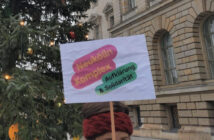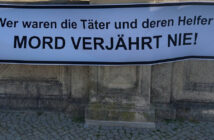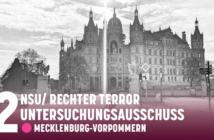The fire on the 4th of November 2001 on Zwickau’s Frühlingsstraße and its consequences were described – primarily through the viewing of several hundred photos. The accusation charges Beate Zschäpe with arson as well as the attempted murder of three people. Small but important details, like the security measures installed in the apartment – in total, the 11 discovered guns as well as the number of beds – gave insight into life in the relative ‘underground.’
[deutsch] [türkçe]
The session begins at 9:45. During roll-call judge Manfred Götzl determines that attorney Anja Sturm, Beate Zschäpe’s lawyer is not present today. Dr. Setzensack is present as expert witness from the Bayern State Office of Criminal Investigation (LKA).
Today, the proceedings focus on the Fire in Zwickau’s Frühlingstraße 26, Mundlos, Böhnhardt and Zschäpe’s last apartment before the NSU was exposed on the 4th of November 2011. The first witness is police chief St., from the K9 School in Saxon. St. states that he was on call on the 5th of November 2011. He received a call that a row house in Zwickau exploded. He arrived with two service dogs, one that searches for cadavers and one that searches for traces of incendiaries. His colleague L. [the next witness]was already present. Initially, they focused on settling the question of missing persons. However, no corpses were found. The incendiary-sniffing dog already indicated in the stairwell [the presence of incendiaries], however, as well as several times in the apartment on the second floor. In agreement with his colleague, he then performed a second search on the 7th of November, this time with a co-worker that likewise lead an incendiary-sniffing dog. Next, the court examined some sketches and photos. The photos primarily showed the dogs as they indicated [the presence of incendiaries]. St. says in that regard: “The dog does not freeze up, rather it lays itself down and shows where the incendiary is.” One of the co-plaintiffs asks what triggers the dogs. St. answers: “The dogs are educated in such a manner that the they can locate the original incendiary and point to it.” After the question was made more concrete, he says that its conventional incendiaries that can be bought at gas stations or hardware stores; for example gasoline, diesel, or thinner. The multiple dogs had confirmed each other’s findings in several places, says St.
Next up is the witness police inspector L., arson investigator with the south-west Saxon police headquarters, who was entrusted with the investigation into the cause of the fire in Frühlingstraße 26 from the 4th to the 28th of November 2011 including all evidence traces until the case was handed off to the BKA [Bundeskriminalamt: Federal Criminal Police Office]. L. initially described the scope of his involvement. The Fire department arrived at the site of the fire at 15:15, the criminal investigation department at 15:45, and he himself at around 18:00. The fire in the apartment was already over. The walls on two sides were burnt out, and debris lay on the sidewalk and street. According to the initial investigation, three people must have been in the house. A woman had already been seen, as she left the house, from which they reasoned that they were still looking for two men. Because the building was, according to structural engineers, in danger of collapse, an excavator removed parts of the structure. The building was surveiled twenty-four-seven from the 4th of November to the 28th of November in order to prevent strangers from staying there. After the excavator was deployed, steel uprights were installed. Afterward, cadaver- and incendiary-sniffing dogs examined the house. The incendiary-sniffing dogs found several traces. On Saturday the USBV-force [USBV = Non-conventional Explosive and Incendiary Squad] came to the site. On Sunday an explosive-sniffing dog examined the property. A high concentration of gasoline was identifiable, the site smelled very strongly of it. A gas explosion could be excluded, because only the neighboring house 26a had Gas, but everything was in working order there. He then split the residence up into individual areas. At the site there was, amongst other things, a safe that “was verifiably open” and in the fire debris that was transported outside by the excavator. They found a total of 11 weapons plus ammunition. The entire debris from the fire was examined for evidence until the 11th of November. Found objects were bagged on site and lain out and dried in the Zwickau police’s garage. The Saxon LKA took traces from the 22 places in the apartment where the dogs had indicated – distributed throughout the whole house – and verified the presence of gasoline in 19 places. Three places could not be determined. Likely there was gasoline there, because the dogs are better than laboratory analysis. Finally, the building was demolished, in order to see if there were any hollow spaces.
In the following, pictures from the photo-slide portfolios that L. produced were examined and L. explicated individual slides. The portfolios are very detailed. They show the fire, the measures taken by the fire department to extinguish it, the safety measures taken and then the preservation of evidence after the fire. Moreover, they show the meticulousness with which the arson investigators proceeded. According to L., he took the majority of the pictures. The photos showing the fire are partially taken by the fire department or other police officers or from a video taken by a pedestrian. To begin with, survey sketches were shown. The first photo shows the house in a historical picture from about 1900. Before proceeding to the fire and the investigation, L. shows survey photos from the time before the fire. According to L., they come from a house appraisal from the 24th of October 2011. May of the photographs showed the building’s “breech security.” The photos of forensics in the burned apartment always show the condition before and then the condition after the police removed the debris from the room.
The building on Zwickau’s Frühlingstraße is made of two halves with the house numbers 26 and 26a. The apartment that burned was in number 26. The apartment was the only occupied apartment in number 26 and took up the entire first floor. The cover name “Dienelt” was on the buzzer to the apartment and on the mailbox were the cover names “Dienelt” and “Burkhardt.” In the downstairs there was an empty restaurant and in the attic two apartments were newly built. The door to the apartment was around the back of the house. The burned down apartment had two entrance doors, however the entrance door from the left side of the stairwell was obstructed from inside the apartment so that it could no longer be used. The apartment could only be entered from the right entrance door. Aside from the two bathrooms, halls and the kitchen the apartment had four rooms. L. had divided the house into “fire areas” that corresponded, more or less, with the rooms and were signified with letters. In addition, L. had given names to the rooms, according to their suspected use. After hall, bathroom and kitchen, the following rooms clockwise: living room, exercise room (a bench press and a treadmill were set up), storeroom (separated from the exercise room by a wall that was later built), bedroom, a room for cats (there was a cat climbing structure), the second bathroom and another hall. The living room, exercise room and sleeping room all faced Frühlingstraße, the cat’s room faced the outgoing Veilchenweg. In the apartment they found four beds, namely in the living room, exercise room, bedroom and cat’s room. According to L., there was a television in every room, the largest in the cat’s room.
Gasoline traces were found in practically every room in the apartment. Traces were also found on the ground floor in the stairwell, however they had not burned. When the gasoline burned, the temperature reached over 1,000 degrees, said L. According to L., they found a ten-liter gas canister in front of the apartment on the first. The canister had been moved, but he discovered its original position after asking the firefighters. In the majority of the apartment, damage was done through a rollover [in fires in contained areas, explosive gases rise to the ceiling and continue to be heated, spreading until they ignite explosively], such that everything was in flames at once. This type of ignition occurred in the living room, first after the fire department was already there. The door to the exercise room was probably closed. The door from the living room to the kitchen was open. In contrast, the fire did not seriously damage the kitchen. In the first hallway, whose doors were likewise closed, the fire was not so severe. Likewise the first bathroom, that exits to the right from this hall. There was a separate fire and one could identify that there was a very high concentration of gasoline there. In these three rooms officials were able to secure many undamaged items. Amongst other things, there are photos showing the almost undamaged groceries in the refrigerator. The photos show the fire’s severity. One can see the largely burned out wall in front of the bedroom and living room. The rest of the wall was, according to L., pushed about 40 centimeters in the direction of the street. One clearly sees cracks in the remaining walls. Some pictures show the so-called debris-shadows, that is, the areas where the debris was shot away by the explosion. Debris was flung onto the sidewalk and street. A picture shows the living room of an older woman that lives on the first floor of 26a. In the wall abutting number 26, there are deep cracks in the plaster and wallpaper. Smoke had already penetrated into the neighbor’s apartment and the wall was moved several millimeters, said L.
In the apartment they found 11 weapons. L. clarified with the help of a sketch. The first weapon was found in the bedroom. It was loaded, although the fire triggered the bullets. Weapon number 2 was found in a safe in the bedroom that was demonstrably open. They also found handcuffs there. These probably “belonged to the [female]colleague.” At this point attorney Stahl, Zschäpe’s defense attorney, this is a value judgment. His colleague attorney Heer assisted, saying the witness is adding new information in passing that does not relate to his responsibilities. Götzl said that L. had certainly spoken with his colleague, that’s normal. The examination of the photos continues. Weapon number three, according to L., was found in the hallway in front of the second bathroom. The remaining weapons and ammunition were found in the rubble removed by the excavator. Moreover, paper money was found in the fire area L.
The extensive security measures in the apartment were conspicuous. According to L., there were four surveillance cameras in the apartment. The apartment door, over the brass plate with the cover name “Dienelt” the peephole had been replaced with a camera. One can see in the pictures that the door itself was reinforced with a deadbolt that was both horizontally and vertically anchored. L. said that on the window bank in the kitchen there was a camera hidden in a box full of artificial flowers. In one of the pictures to this subject, an ashtray, a lighter, and a green package of “Pall Mall” cigarettes can be seen. The camera in the kitchen was aimed at the door to the building. The other cameras were probably built onto the window banks in a similar manner in the living and cat’s room. The camera in the kitchen was retrieved almost entirely undamaged. The camera in the living room was washed into the room by the water used to extinguish the fire. The camera in the cat’s room was, as shown in pictures from the fire, so intensely damaged during the fire that it fell onto the sidewalk. L. points out in particular that the flower box in which the camera in the living room window was found was not present in the pictures from the October 2011 appraisal. According to L., the cameras were connected to each other with cables that were “correctly installed.” The undamaged basement of the residents of the burned room was particularly well secured. It was indicated by a glued on sign with the text “Dienelt’s Cellar” and was closed on both sides with steel doors. The doors were, according to L., furnished with a radio alarm that would send a signal to a station in the apartment when the doors were opened.
After four different photo slide portfolios and approximately 400 individual photos, judge Götzl interrupts the examination and announces that he wants to hear L. and the expert witness Setzensack again on the 17th and possibly the 18th of July.
At 16:00 the day’s session ends.
Co-plaintiff representative Attorney Peer Stolle explains:
“The NSU’s ‘confession in evidence’ has a significant meaning for the trial, and in particular for the question of Beate Zschäpe’s guilt. Cameras in flower boxes, 11 weapons in the apartment alone along with the ammunition and in part loaded, numerous news reports about the murders and attacks, as well as reconnaissance plans for other potential targets; the accused must have known about it. These things play a decisive role in showing her intent and the alleged organization within the NSU.”


